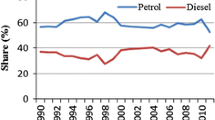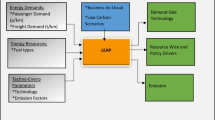Abstract
The energy sector has grown significantly over the years, causing an increase in carbon emission that has led to serious global warming problems. Consequently, electric vehicles (EVs) have become a favourable solution in the transportation sector due to their green technology attributes. This paper aims to apply the Carbon Emission Pinch Analysis (CEPA) method to the transportation sector in Iskandar Malaysia. The modified CEPA method is applied by constructing a composite curve for transportation modes and the total carbon emission was plotted in order to study the minimum electricity requirement that needs to be generated to implement the use of EVs. Road and rail transportation were considered in the transport composite curve based on the current policies available and to achieve the new carbon emission target by the year 2025. The alternatives available to reduce carbon emission in Iskandar Malaysia include increasing public transport modal share; fuel switching from petrol and diesel to natural gas and biofuels; and increasing transport efficiency via plug-in hybrid and EVs. Four scenarios were established and evaluated based on economic and environmental aspects. As a result, Scenario 4 which considered all policies available (transport management, fuel switching and fuel efficiency) have showed the most promising fuel mix for future transportation demands. An estimated total amount of 0.25 TJ of electricity is needed for EV implementation with a total estimated cost of RM 1.3 billion. The total carbon emission for this scenario is 1101.96 kt-CO2. This research can benefit the Government, town planners, or policy makers, for preliminary energy planning.


(Reproduced with permission from Walmsley et al. 2015b)







Similar content being viewed by others
References
Atkins MJ, Morrison AS, Walmsley MRW (2010) Carbon Emissions Pinch Analysis (CEPA) for emissions reduction in the New Zealand electricity sector. Appl Energy 87(3):982–987
Bhowmik C, Bhowmik S, Ray A, Pandey KM (2017) Optimal green energy planning for sustainable development: a review. Renew Sustain Energy Rev 71:796–813
Cavallaro F, Novera S (2016) The competitiveness of alternative transport fuels for CO2 emissions. Transp Policy 50:1–14
Crilly D, Zhelev T (2008a) Emissions targeting and planning: an application of CO2 emissions pinch analysis (CEPA) to the Irish electricity generation sector. Energy 33(10):1498–1507
Crilly D, Zhelev T (2008b) Further emissions and energy targeting: an application of CO2 emissions pinch analysis to the Irish electricity generation sector. Clean Technol Environ Policy 12:177–189
Ho CS, Matsuoka Y, Simson J, Gomi K (2013a) Low carbon urban development strategy in Malaysia—the case of Iskandar Malaysia development corridor. Habitat Int 37:43–51
Ho CS, Matsuoka, Y, Chau LW, Teh BT, Simson JJ, Gomi K (2013b) Blueprint for the development of low carbon society scenarios for Asian regions—case study of Iskandar Malaysia. In: 4th International conference on energy and environment
Ho WS, Hashim H, Lim JS, Lee CT, Sam KC, Tan ST (2017) Waste Management Pinch Analysis (WAMPA): application of pinch analysis for greenhouse gas (GHG) emission reduction in municipal solid waste management. Appl Energy 185:1481–1489
Hosseini SE, Wahid MA, Aghili N (2013) The scenario of greenhouse gases reduction in Malaysia. Renew Sustain Energy Rev 28:400–409
International Energy Agency (2016) Excerpt from: CO2 emissions from fuel combustion. Key CO2 emissions trends
Madanipour V, Montazeri-Gh M, Mahmoodi-k M (2016) Multi-objective component sizing of plug-in hybrid electric vehicle for optimal energy management. Clean Technol Environ Policy 18:1189–1202
Matsuoka Y et al (2009) Low carbon city 2025: sustainable Iskandar Malaysia. http://2050.nies.go.jp/report/file/lcs_asialocal/iskandarlcs.pdf
Mustapa SI, Bekhet HA (2016) Analysis of CO2 emissions reduction in the Malaysian transportation sector: an optimisation approach. Energy Policy 89:171–183
Oh TH, Pang SY, Chua SC (2010) Energy policy and alternative energy in Malaysia: issues and challenges for sustainable growth. Renew Sustain Energy Rev 14:1241–1252
Ooi REH, Foo DCY, Ng DKS, Tan RR (2013) Planning of carbon capture and storage with pinch analysis techniques. Chem Eng Res Des 91:2721–2731
Resitoglu IA, Altinisik K, Keskin A (2015) The pollutant emissions from diesel-engine vehicles and exhaust aftertreatment systems. Clean Technol Environ Policy 17:15–27
Rudolph C (2016) How many incentives for electric cars affect purchase decision? Transp Policy 52:113–120
Tan RR, Foo DCY (2007) pinch analysis approach to carbon-constrained energy sector planning. Energy 32(8):1422–1429
Tan RR, Ng DKS, Foo DCY (2009a) pinch analysis approach to carbon-constrained planning for sustainable power generation. J Clean Prod 17:940–944
Tan RR, Foo DCY, Aviso KB, Ng DKS (2009b) The use of graphical pinch analysis for visualizing water footprint constraints in biofuel production. Appl Energy 86:605–609
Tjan W, Tan RR, Foo DCY (2010) A graphical representation of carbon footprint reduction for chemical processes. J Clean Prod 18:848–856
Walmsley MRW, Walmsley TG, Atkins MJ, Kamp PJJ, Neale JR (2014) Minimising carbon emissions and energy expended for electricity generation in the New Zealand through to 2050. Appl Energy 135:656–665
Walmsley MRW, Walmsley TG, Atkins MJ (2015a) Achieving 33% renewable electricity generation by 2020 in California. Energy 92:260–269
Walmsley MRW, Walmsley TG, Atkins MJ, Kamp PJJ, Neale JR, Chand A (2015b) Carbon emissions pinch analysis for emissions reduction in the New Zealand transport sector through to 2050. Energy 92:569–576
Acknowledgements
This work was financially supported by Universiti Teknologi Malaysia under the Research University Grants (RUG) with Vote Nos. Q.J130000.2546.14H53, Q.J130000.2446.03G61, Q.J130000.2546.19H05 and Q.J130000.2546.12H89.
Author information
Authors and Affiliations
Corresponding author
Rights and permissions
About this article
Cite this article
Ramli, A.F., Muis, Z.A., Ho, W.S. et al. Carbon Emission Pinch Analysis: an application to the transportation sector in Iskandar Malaysia for 2025. Clean Techn Environ Policy 21, 1899–1911 (2019). https://doi.org/10.1007/s10098-018-1579-2
Received:
Accepted:
Published:
Issue Date:
DOI: https://doi.org/10.1007/s10098-018-1579-2




